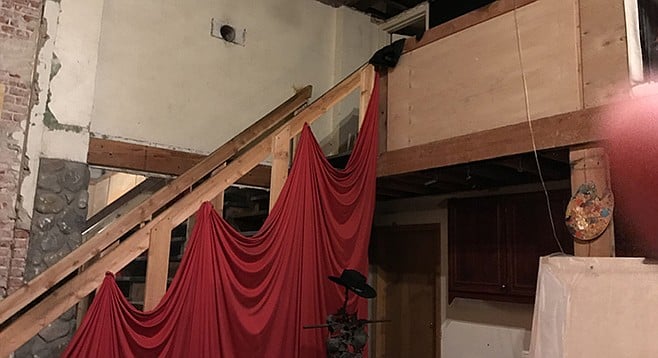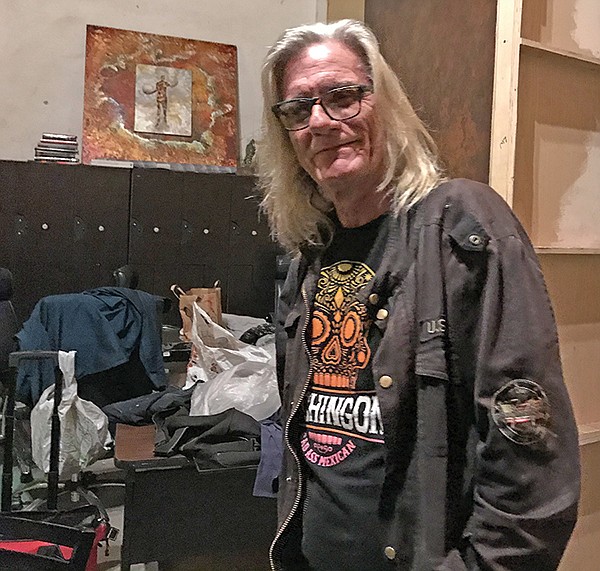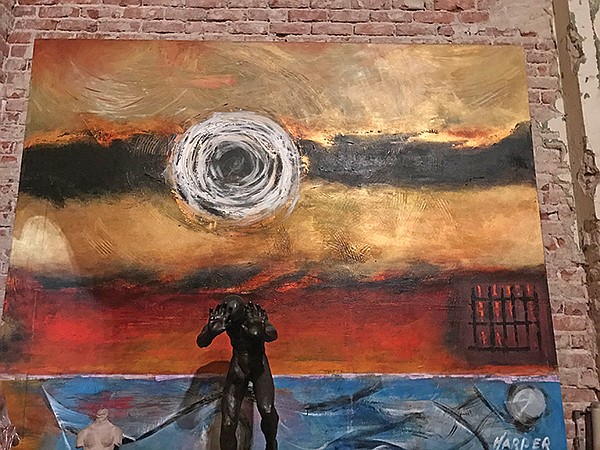 Facebook
Facebook
 X
X
 Instagram
Instagram
 TikTok
TikTok
 Youtube
Youtube

“Let me show you something,” says Gary Harper. It’s around nine on a Thursday night. We’re both taking a moment out on the sidewalk away from the music at Border X in Barrio Logan. I was just saying how the barrio was changing.

He leads me a short way down Logan Avenue to what looks like an old warehouse. He fumbles with keys, and presto! We’re inside what could be an ancient lobby.
“If you were standing right here 104 years ago, you would have been in the foyer of the newest theater in town,” Harper says. “The Metro. This was where all the kids of the barrio came on Saturday afternoons to see cartoons and movies. Adults sometimes came to see live burlesque. I lease this as my studio now, but the theater’s intact.”
Harper is an artist, a bit of an entrepreneur and a designer of bars. “Havana in the Gaslamp, El Chingon, Meze, Border X. Had a hand in all of them.”

We’ve just come through a plywood division wall separating the foyer from the main auditorium. It seems all the bigger for the high exposed timber roof and naked brick walls.
Well, not quite naked. “That’s one of mine,” Harper says, pointing to a mostly abstract four-by-six-foot painting leaning against the wall, mainly cream-black-red-blue horizontal bars, with either a beating sun or a black hole in the middle. “It’s called Deep Thoughts,” he says. “Just sold it for $16,000. Someone on the East Coast.”
Standing in front of Deep Thoughts is a life-filled sculpture of a man with his hands ready to buffer off some threat. “That [was done by sculptor] Bobi Postelnek. Selling for $15-$20,000. She’s famous. Lives in the Barrio.”
“So, with artists like you and her, things are changing? Gentrification?” I say. “Rents rising? The next cool place?”
“Well,” Harper says, “everything changes, but not really. Like, this Metro Theater is where the community has been coming together since 1914. And yes, I’m here now. But I know there are legacies be respected.”
He says he even has a real ghost, “a lady in a Victorian white dress” who sometimes moves through the empty spaces at night.
“But it’s more than that,” he says. “I’m Gringo, and the first advice I got when I moved in here was to play it slow. Show respect. Learn. And let people get used to me. Not be pushy. So I spent countless afternoons sitting outside, reading, saying hi, just kind of being here, letting people know I wanted to be part of this community.”
A big breakthrough came recently, Harper says, when he overheard a couple of local heavy hitters passing by, looking at him.
“‘O.G.,’” one of them mumbled to the other. “I had to ask around. What did that mean? ‘Oh God’? ‘Old Guy’? Like I was still a stranger? ‘Oh no,’ this friend of mine said. ‘That meant “Original Gangster.” That meant you’d paid your dues, been around long enough to be accepted.’ I tell you, that meant more to me than anything I could have heard. The barrio only accepts change on its own terms.”


“Let me show you something,” says Gary Harper. It’s around nine on a Thursday night. We’re both taking a moment out on the sidewalk away from the music at Border X in Barrio Logan. I was just saying how the barrio was changing.

He leads me a short way down Logan Avenue to what looks like an old warehouse. He fumbles with keys, and presto! We’re inside what could be an ancient lobby.
“If you were standing right here 104 years ago, you would have been in the foyer of the newest theater in town,” Harper says. “The Metro. This was where all the kids of the barrio came on Saturday afternoons to see cartoons and movies. Adults sometimes came to see live burlesque. I lease this as my studio now, but the theater’s intact.”
Harper is an artist, a bit of an entrepreneur and a designer of bars. “Havana in the Gaslamp, El Chingon, Meze, Border X. Had a hand in all of them.”

We’ve just come through a plywood division wall separating the foyer from the main auditorium. It seems all the bigger for the high exposed timber roof and naked brick walls.
Well, not quite naked. “That’s one of mine,” Harper says, pointing to a mostly abstract four-by-six-foot painting leaning against the wall, mainly cream-black-red-blue horizontal bars, with either a beating sun or a black hole in the middle. “It’s called Deep Thoughts,” he says. “Just sold it for $16,000. Someone on the East Coast.”
Standing in front of Deep Thoughts is a life-filled sculpture of a man with his hands ready to buffer off some threat. “That [was done by sculptor] Bobi Postelnek. Selling for $15-$20,000. She’s famous. Lives in the Barrio.”
“So, with artists like you and her, things are changing? Gentrification?” I say. “Rents rising? The next cool place?”
“Well,” Harper says, “everything changes, but not really. Like, this Metro Theater is where the community has been coming together since 1914. And yes, I’m here now. But I know there are legacies be respected.”
He says he even has a real ghost, “a lady in a Victorian white dress” who sometimes moves through the empty spaces at night.
“But it’s more than that,” he says. “I’m Gringo, and the first advice I got when I moved in here was to play it slow. Show respect. Learn. And let people get used to me. Not be pushy. So I spent countless afternoons sitting outside, reading, saying hi, just kind of being here, letting people know I wanted to be part of this community.”
A big breakthrough came recently, Harper says, when he overheard a couple of local heavy hitters passing by, looking at him.
“‘O.G.,’” one of them mumbled to the other. “I had to ask around. What did that mean? ‘Oh God’? ‘Old Guy’? Like I was still a stranger? ‘Oh no,’ this friend of mine said. ‘That meant “Original Gangster.” That meant you’d paid your dues, been around long enough to be accepted.’ I tell you, that meant more to me than anything I could have heard. The barrio only accepts change on its own terms.”
Comments